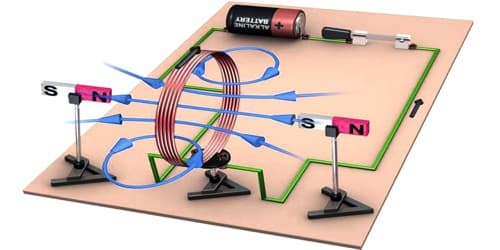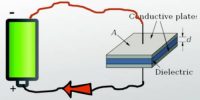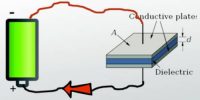Voltage sensitivity is the measure of the responsiveness of an appliance to the transform of applied voltage across it. A galvanometer is a type of ammeter. It is an appliance for detecting and measuring electric current
So, the voltage sensitivity of a galvanometer is defined as the deflection per unit voltage across the galvanometer.
So, Voltage sensitivity = θ/V = θ/IG = nBA/CG
where G is the galvanometer resistance.
Unit: rad V-1 or mm V-1
High voltage sensitivity is desirable in circuits of relatively low resistance.
An interesting point to note is that increasing the current sensitivity does not necessarily, increase the voltage sensitivity. When the number of turns (n) is doubled, current sensitivity is also doubled (equation). But increasing the number of turns correspondingly increases the resistance (G). Hence voltage sensitivity remains unchanged.
So, we can say, Voltage Sensitivity = θ/V = (NAB/KR)
where,
- θ is the angular displacement, i.e. the reading you see on the galvanometer
- V is, of course, the voltage across the galvanometer for which the reading is θ
- N is the number of turns of the moving-coil in the galvanometer.
- A is the length of the rectangular-coil, B is the breadth of the rectangular-coil,
Therefore AB represents the area of the 2D-coil.
K is the torsion-constant of the galvanometer, i.e., the spring constant of the spring that’s used in the galvanometer.
R is the resistance of the coil.
Now, increasing the number of turns N of the coil will result in the same increase in the resistance of the coil R as R∝ l and surface-area of the coil is kept stable.
Therefore, the increasing number of turns N of the coil does not affect the voltage-sensitivity of the galvanometer.
Therefore, in order to increase the voltage-sensitivity of the galvanometer,
- You can increase the area of the coil
- You can decrease the torsion-constant of the galvanometer.
In moving coil galvanometer voltage sensitivity is openly comparative to the number of turns & is inversely proportional to the resistance but on increasing the number of turns length of wire increases which increases the resistance of the wire this shows sensitivity increases on increasing the resistance.
Observations
- To increase the voltage compassion, softer the spring lower will be the spring constant and higher will be the voltage compassion.
- Thicker the wire lower will be the resistance and higher will be the voltage sensitivity.
- Larger the number of turns greater will be the voltage sensitivity.
- Stronger the magnetic field greater will be the voltage sensitivity.
- Larger the area greater will be the sensitivity.















